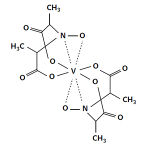Researchers from the University of Graz have developed a method to determine the vanadium-complex amavadin that occurs in the fly agaric mushroom. The method is based on high-performance liquid chromatography hyphenated (HPLC) with inductively coupled plasma-mass spectrometry (ICP-MS) and allows for the sensitive determination of amavadin and other V-containing compounds in environmentally and biological samples.
Background:Vanadium is omnipresent in the terrestrial and aquatic environment. Vanadium is the second-to-most abundant transition metal in sea-water, exceeded only by molybdenum (100 nM), and clearly more abundant than iron (≤0.7 nM). Vanadium is thus generally available for living organisms. Despite such omnipresence in the environment, the biological function of this element has been established mainly for some primitive forms of life (cyanobacteria, algae, fungi and lichens) while its role for higher organisms is still unclear.

Figure: Structure of amavadin
|
The macrofungus Amanita muscaria, also known as fly agaric, is one of those organisms that accumulates vanadium to relatively high concentrations surpassing 100 mg V/kg dry mass. Since 1972 it is known that V is present in the mushroom as a negatively charged compound (pH 1–10), which was named “Amavadin". Since then its structure and behaviour has been investigated by techniques such as electron paramagnetic resonance (EPR) spectroscopy, infrared (IR) spectroscopy, crystallography, X-ray absorption spectroscopy and nuclear magnetic resonance (NMR) spectroscopy. However, the biological role of amavadin is still unknown and the knowledge of its occurrence, biosynthesis and distribution in different macrofungi is limited.
A first requirement for further studies is a selective and sensitive speciation analysis method. Unfortunately, most developed methods for V speciation have been focused on the determination of V(IV) and V(V) in water and aqueous extracts, V porphyrins in mineral oil and molecular size fractions in blood and tissue samples.
The new study:
Researchers from the University of Graz now filled the gap by developing a method for the sensitive detection of amavadin and related V species with HPLC-ICP-MS. For HPLC separation an anion-exchange column (Zorbax SAX) and an aqueous mobile phase with ammonium citrate were used. EDTA was added to the mobile phase in order to complex all present smaller V species, thus avoiding unwanted precipitation or species interconversion. The HPLC separation was optimized with respect to column temperature, citric acid concentration and pH value. The optimized method was validated for a working range between 0 and 100 µg/L amavadin and vanadyl acetate. Using the final method, amavadin is eluted in less than 17 minutes, and its limit of detection is 0.05 µg V/L. Moreover, the compound's two isomers are separated from each other and can be quantified independently.
Different parts of the mushrooms (cap, strip, gills, bulb and skin) were extracted with the mobile phase within an ultrasonic bath. After filtration through 0.22 µm nylon filters, the extracts were subjected to HPLC-ICP-MS analysis without further dilution. The extraction efficiency was 74 ± 12%, and amavadin accounted for 75–96% of the extracted V. Highest amavadin concentrations (up to 83 mg V/kg) were found in the bulbs. In addition, significant concentrations of other V species could be detected, which have never been described before.
The authors concluded that V speciation in mushrooms is more complex than assumed until now, and that more in-depth investigations on this matter are needed.
 The Original study
The Original study
Simone Braeuer, Martin Walenta, Lorenz Steiner,
Walter Goessler, Determination of the naturally occurring vanadium-complex amavadin in Amanita muscaria with HPLC-ICPMS, J. Anal. At. Spectrom., 36/5 (2021) 954-967.
DOI: 10.1039/d0ja00518e
 Used techniques and instrumentation:
Used techniques and instrumentation: Agilent Technologies Inc. - 8900 ICP-MS/MS
Agilent Technologies Inc. - 8900 ICP-MS/MS Agilent Technologies Inc. - 6120 LC/MS
Agilent Technologies Inc. - 6120 LC/MS
 Related studies (newest first)
Related studies (newest first)

M. Jensen-Fontaine, W. P. Norwood, M. Brown, D. G. Dixon,
X. C. Le,
Uptake and Speciation of Vanadium in the Benthic Invertebrate Hyalella azteca, Environ. Sci. Technol., 48 (2014) 731–738.
DOI: 10.1021/es403252k

N. Kilibarda, S. E. Afton, J. M. Harrington, F. Yan, K. E. Levine,
Rapid speciation and determination of vanadium compounds using ion-pair reversed-phase ultrahigh-performance liquid chromatography inductively coupled plasma-sector field mass spectrometry, J. Chromatogr. A, 1304/1 (2013) 121–126.
DOI: 10.1016/j.chroma.2013.06.074
T. Iglesias-González, C. Sánchez-González,
M. Montes-Bayón, J. Llopis-González and
A. Sanz-Medel,
Absorption, transport and insulin-mimetic properties of bis(maltolato) oxovanadium (IV) in streptozotocin-induced hyperglycemic rats by integrated mass spectrometric techniques, Anal. Bioanal. Chem., 402/1 (2012) 277–285.
DOI: 10.1007/s00216-011-5286-7

Z. L. Chen and G. Owens,
Trends in speciation analysis of vanadium in environmental samples and biological fluids—A review, Anal. Chim. Acta, 607/1 (2008) 1–14.
DOI: 10.1016/j.aca.2007.11.013

F. Aureli, S. Ciardullo, M. Pagano, A. Raggi and
F. Cubadda, Speciation of vanadium(IV) and (V) in mineral water by anion exchange liquid chromatography-inductively coupled plasma mass spectrometry afer EDTA complexation, J. Anal. At. Spectrom., 23/7 (2008) 1009–1016.
DOI: 10.1039/b805234b

X. S. Li and
X. C. Le,
Speciation of vanadium in oils and coke and bacterial culture by high performance liquid chromatography inductively coupled plasma mass spectrometry, Anal. Chim. Acta, 602/1 (2007) 17–22.
DOI: 10.1016/j.aca.2007.09.004
M. Colina, P. H. E. Gardiner, Z. Rivas and F. Troncone,
Determination of vanadium species in sediment, mussel and fish muscle tissue samples by liquid chromatography inductively coupled plasma-mass spectrometry, Anal. Chim. Acta, 538/1-2 (2005) 107–115.
DOI: 10.1016/j.aca.2005.02.044
 Related EVISA Resources
Related EVISA Resources
 Related EVISA News
Related EVISA News
last time modified: Janiary 11, 2025